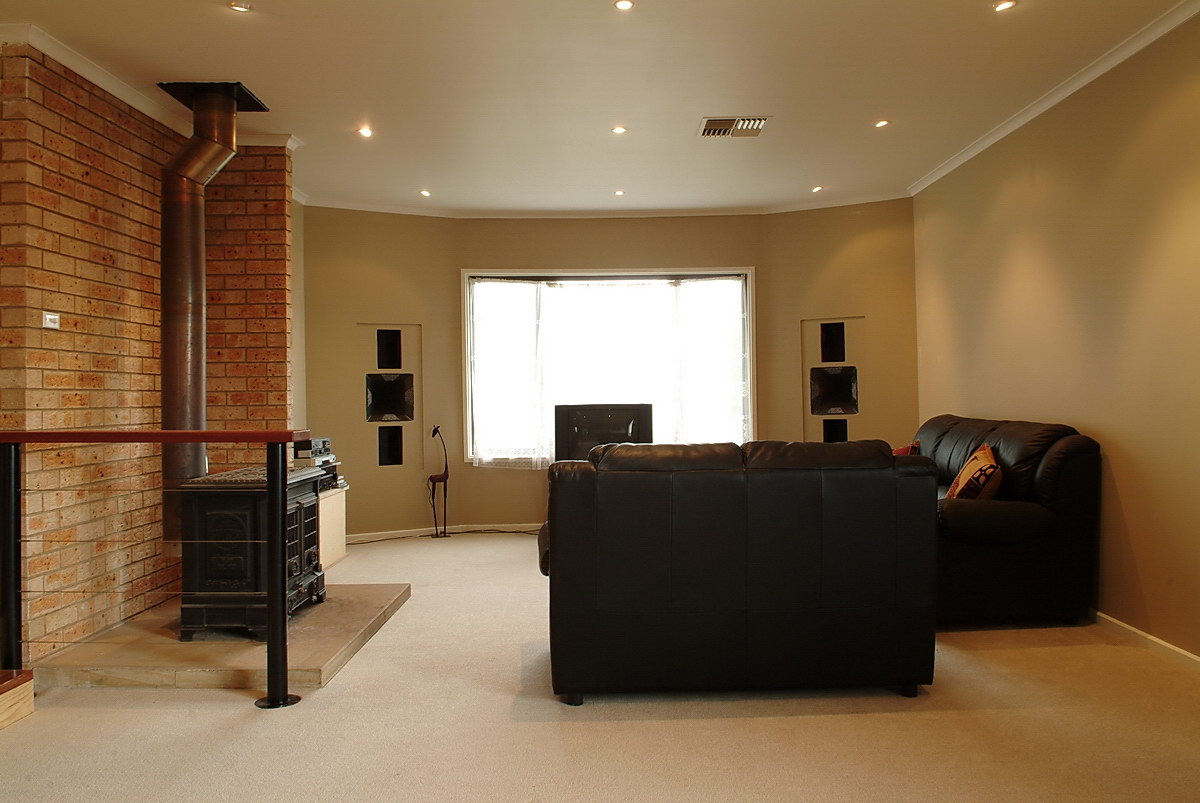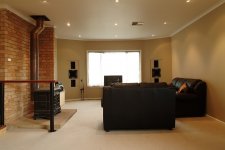As far as I know, there are currently only 3 Unity horns in Australia, one of which I've heard. I'm planning to build the 4th with some changes.

That's the concept. 60 x 90 degree hybrid waveguide. Waveguide for the top end, but the midranges are horn loaded.
B&C DE250 compression driver
Misco mid (probably)
Peavey Black widow 18" woofer vented box
Planning to do an oblate spheroid waveguide, either rectangular and possibly elliptical. CNC potentially, although probably I'll start with something I can build quickly. Also I plan to use reticulated foam as I've found it makes a huge improvement to waveguides. I'd like to include Synergy horn improvements when I actually start to get my head around what they are. Seems there are improvements with using slots instead of holes and using a frustum profile to them ie the hole is bigger on the driver side.
The idea in installation is similar to William Cowan's which many of you will have seen:

However, instead of soffits, my plan is to use bass traps - so they will sit flush inside very large traps. The woofer cab will have to be shaped so that it does not become a boundary that will defeat the traps - hence I'm thinking a slender box with curved sides, which will also add stiffness and allow them to be lighter.
The plan is to then run some subs clustered together under one corner in a huge tapped horn under floor setup. Probably my existing Rythmik subs running about 15 - 50 Hz where 4 of them together will get maximum efficiency.
I still have quite a bit to nut out about the Unity/Synergy ...
1. Is there a benefit to using a phase plug with the mids? I can build them if necessary.
2. Is there a better driver than the misco mid?
3. Is there a consensus on the best shape for the holes? Both in profile and shape.
4. What is the sensitivity of the mid section? Assuming the Misco mid. Seems to me it should be about the same as a compression driver.
5. Apart from being 3 way + woofer, are there other developments in the Synergy that could be used here?
I'm also interested to hear various listening impressions from those who have actually heard either Unity or Synergy.

That's the concept. 60 x 90 degree hybrid waveguide. Waveguide for the top end, but the midranges are horn loaded.
B&C DE250 compression driver
Misco mid (probably)
Peavey Black widow 18" woofer vented box
Planning to do an oblate spheroid waveguide, either rectangular and possibly elliptical. CNC potentially, although probably I'll start with something I can build quickly. Also I plan to use reticulated foam as I've found it makes a huge improvement to waveguides. I'd like to include Synergy horn improvements when I actually start to get my head around what they are. Seems there are improvements with using slots instead of holes and using a frustum profile to them ie the hole is bigger on the driver side.
The idea in installation is similar to William Cowan's which many of you will have seen:

However, instead of soffits, my plan is to use bass traps - so they will sit flush inside very large traps. The woofer cab will have to be shaped so that it does not become a boundary that will defeat the traps - hence I'm thinking a slender box with curved sides, which will also add stiffness and allow them to be lighter.
The plan is to then run some subs clustered together under one corner in a huge tapped horn under floor setup. Probably my existing Rythmik subs running about 15 - 50 Hz where 4 of them together will get maximum efficiency.
I still have quite a bit to nut out about the Unity/Synergy ...
1. Is there a benefit to using a phase plug with the mids? I can build them if necessary.
2. Is there a better driver than the misco mid?
3. Is there a consensus on the best shape for the holes? Both in profile and shape.
4. What is the sensitivity of the mid section? Assuming the Misco mid. Seems to me it should be about the same as a compression driver.
5. Apart from being 3 way + woofer, are there other developments in the Synergy that could be used here?
I'm also interested to hear various listening impressions from those who have actually heard either Unity or Synergy.
Attachments
Last edited:
Can't believe no one has anything to say about it!
Probably because what you're planning isn't a Unity or Synergy horn. Having the high frequencies covered by a separate wave guide defeats the whole purpose of a Unity. You will lose the coherent imaging, the point source and your minimal phase will be all over the place. What you have planned isn't much different than the usual horn stack we've all seen before.
JLH,
I'm not planning to use a separate waveguide - as you say it would defeat the purpose. Any changes I would make would be within the scope of the Synergy. Things like experimenting with the profile, size and shape of ducts, drivers and using foam. I was referring to the fact that in theory it uses a waveguide typically for the top end, but the same waveguide technically become a horn for the mids because they are compression loaded via ducts. So in that sense it is a hybrid.
The more I read about the Synergy, the more it makes sense. The coax point source is the last thing I'd give up!
I'm not planning to use a separate waveguide - as you say it would defeat the purpose. Any changes I would make would be within the scope of the Synergy. Things like experimenting with the profile, size and shape of ducts, drivers and using foam. I was referring to the fact that in theory it uses a waveguide typically for the top end, but the same waveguide technically become a horn for the mids because they are compression loaded via ducts. So in that sense it is a hybrid.
The more I read about the Synergy, the more it makes sense. The coax point source is the last thing I'd give up!
Ah... I see what you are talking about now. I misunderstood your original post. My apologies. The strong suit for the Unity/Synergy is the conical horn's changing flare rate along its axis. At the throat the flare rate is high, as you move closer to the mouth, the effective flare rate slows. This allows us to load each driver to its optimum frequency range. This avoids the common problem that big horns with single drivers have. The common horn is only ideally loading the driver in a singular frequency range and results in bad phase behavior. Now that I know what I know, I can now laugh at all those large tractix horns I built for compression drivers and small woofer cones. They are bad compromises compared to the Unity/Synergy.
Recently I had some 12" oblate spheroids set up, fibreglass units that look really cool. They had me thinking about some big mid horns, which would loook very cool but in my room they would almost certainly not work. My room is too small and the vertical offset would be a real problem. That's a big part of the Synergy horn appeal. The Synergy also makes it easier to get a good mouth termination as there is just one, so I'm thinking I'll do a generous round over. The Avant Garde horns look amazing, but I can see all kinds of issues with the lack of baffle and vertical offsets.
- Status
- Not open for further replies.
